Research
Postdoctoral Research Position
A NIH-funded postdoctoral position is currently available. The research project focuses on elucidating mechanisms related to copper uptake, transport, and storage in mammalian cells. Review of applications will begin immediately and continue until the position is filled. Additional information can be downloaded from here.Illuminating Copper Transport and Storage
High-Contrast Cu(I)-Selective Fluorescent Probes
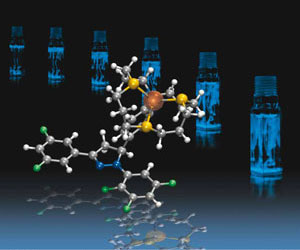
Fluorescent probes are powerful and cost-effective tools for the detection of metal ions in
biological systems. Compared to non-redox-active metal ions, the design of fluorescent probes for biological copper is challenging.
Within the reducing cellular environment, copper is predominantly present in its monovalent oxidation state; therefore,
the design of fluorescent probes for biological copper must take into account the rich redox and coordination chemistry of Cu(I).
Our progress in understanding the underlying solution chemistry and photophysical pathways led to the development of new probes
that offer high fluorescence contrast and excellent selectivity towards monovalent copper.

Fluorescent probes are powerful and cost-effective tools for the detection of metal ions in biological systems. Compared to non-redox-active metal ions, the design of fluorescent probes for biological copper is challenging. Within the reducing cellular environment, copper is predominantly present in its monovalent oxidation state; therefore, the design of fluorescent probes for biological copper must take into account the rich redox and coordination chemistry of Cu(I). Our progress in understanding the underlying solution chemistry and photophysical pathways led to the development of new probes that offer high fluorescence contrast and excellent selectivity towards monovalent copper.
X-ray Fluorescence Imaging of Copper Pools
Synchrotron X-ray fluorescence microscopy (SXRF) is a label-free microanalytical technique that allows for the direct visualization
of the total trace element distribution without the need of an exogenous chemical probe. Given the importance of the trans-Golgi network (TGN) in copper trafficking,
we utilized SXRF to study changes associated with cell lines that are do not express Atox1, a cytoplasmic metallochaperone that is responsible for trafficking
copper to the TGN for injection into the secretory pathway.
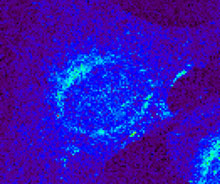
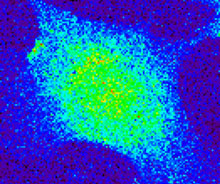
Synchrotron X-ray fluorescence microscopy (SXRF) is a label-free microanalytical technique that allows for the direct visualization of the total trace element distribution without the need of an exogenous chemical probe. Given the importance of the trans-Golgi network (TGN) in copper trafficking, we utilized SXRF to study changes associated with cell lines that are do not express Atox1, a cytoplasmic metallochaperone that is responsible for trafficking copper to the TGN for injection into the secretory pathway.


Affinity Standards for Cu(I) Biochemistry

Cellular copper levels are controlled by an intricate network of membrane transporters and metallochaperones,
which escort the metal ion to specific subcellular locations for incorporation into metalloproteins or export through secretory pathways.
To understand the directivity of these trafficking pathways, a detailed knowledge of the copper binding affinities of all involved ligands is essential.
The measurement of reliable Cu(I) protein binding affinities requires competing reference ligands with
similar binding strengths. In this project, we designed, synthesized and characterized a series of roubust Cu(I)-affinity standards
that form discrete Cu(I) complexes with 1:1 stoichiometry and are capable of buffering Cu(I) concentrations between 10−10 and 10−17 M.

Cellular copper levels are controlled by an intricate network of membrane transporters and metallochaperones, which escort the metal ion to specific subcellular locations for incorporation into metalloproteins or export through secretory pathways. To understand the directivity of these trafficking pathways, a detailed knowledge of the copper binding affinities of all involved ligands is essential. The measurement of reliable Cu(I) protein binding affinities requires competing reference ligands with similar binding strengths. In this project, we designed, synthesized and characterized a series of roubust Cu(I)-affinity standards that form discrete Cu(I) complexes with 1:1 stoichiometry and are capable of buffering Cu(I) concentrations between 10−10 and 10−17 M.
Dynamic Imaging of Zinc During Cell Proliferation and Development
Ratiometric Zn(II)-Selective Fluorescent Probes for Two-Photon Microscopy
Two-photon excitation fluorescence microscopy (TPEM) has rapidly evolved into a widely used
imaging modality in biological and biomedical research. Compared to conventional fluorescence microscopy, TPEM offers intrinsic
3D resolution combined with reduced phototoxicity, increased specimen penetration, and negligible background fluorescence.
In this project, we focus on the development of emission-ratiometric Zn(II)-selective fluorescent probes that are optimized for
the use in two photon excitation microscopy. The probes are built upon a donor-acceptor motif that elicits a strong
spectral shift upon binding of Zn(II) while maintaining a balanced two-photon cross section. Our current efforts are geared towards expanding
the affinity range of the probes and further optimizing their photophysical properties.
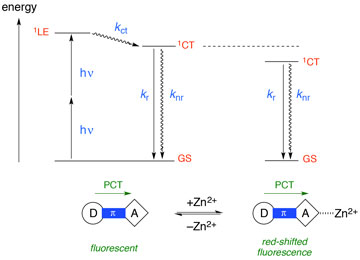
Two-photon excitation fluorescence microscopy (TPEM) has rapidly evolved into a widely used imaging modality in biological and biomedical research. Compared to conventional fluorescence microscopy, TPEM offers intrinsic 3D resolution combined with reduced phototoxicity, increased specimen penetration, and negligible background fluorescence. In this project, we focus on the development of emission-ratiometric Zn(II)-selective fluorescent probes that are optimized for the use in two photon excitation microscopy. The probes are built upon a donor-acceptor motif that elicits a strong spectral shift upon binding of Zn(II) while maintaining a balanced two-photon cross section. Our current efforts are geared towards expanding the affinity range of the probes and further optimizing their photophysical properties.

Inheritance of Zinc During Mitosis

Despite the importance of trace metals to cell proliferation, mechanisms governing their regulation,
re-distribution, and ultimate partitioning into the daughter cells upon completion of cell division remain largely unexplored.
In this project, we employ a combination of synchrotron x-ray fluorescence imaging and two-photon excitation microscopy to
unravel the redistribution of transition metals in NIH 3T3 cells as they pass through the indidual mitotic stages.
Our studies revealed an intriguing redistribution dynamics of zinc and copper as well as an unexpected sharp increase of
cellular zinc levels in mitotic compared to interphase cells.

Despite the importance of trace metals to cell proliferation, mechanisms governing their regulation, re-distribution, and ultimate partitioning into the daughter cells upon completion of cell division remain largely unexplored. In this project, we employ a combination of synchrotron x-ray fluorescence imaging and two-photon excitation microscopy to unravel the redistribution of transition metals in NIH 3T3 cells as they pass through the indidual mitotic stages. Our studies revealed an intriguing redistribution dynamics of zinc and copper as well as an unexpected sharp increase of cellular zinc levels in mitotic compared to interphase cells.
3D Imaging of Trace Elements by X-ray Fluorescence Tomography
By acquiring a series of X-ray fluorescence tomographic projections over a 180 or 360 degree angular space, it is possible to reconstruct the
3D distribution of transition elements with submicron resolution. As the mechanical stability, both of the instrument and the specimen, is paramount when acquiring
tomographic projection series, we explored in this project the utility of polyacrylamide-based embedding materials as X-ray comaptible transparent resins for
tomographic elemental imaging. bAsed on this approach, we reconstructed the 3D distribution of zinc, iron, and copper of an intact zebrafish
embryo at 24 hours post fertilization. The volumetric elemental maps revealed distinct elemental distributions that could be correlated with
characteristic anatomical features at this stage of embryonic development.
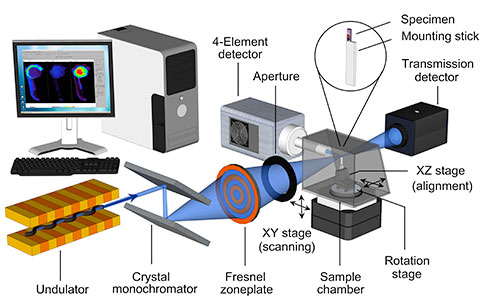
By acquiring a series of X-ray fluorescence tomographic projections over a 180 or 360 degree angular space, it is possible to reconstruct the 3D distribution of transition elements with submicron resolution. As the mechanical stability, both of the instrument and the specimen, is paramount when acquiring tomographic projection series, we explored in this project the utility of polyacrylamide-based embedding materials as X-ray comaptible transparent resins for tomographic elemental imaging. bAsed on this approach, we reconstructed the 3D distribution of zinc, iron, and copper of an intact zebrafish embryo at 24 hours post fertilization. The volumetric elemental maps revealed distinct elemental distributions that could be correlated with characteristic anatomical features at this stage of embryonic development.

Low-Background Imaging with Fluorescent Proteins
Long-wavelength Modulation

Cellular autofluorescence represents a major challenge in fluorescence imaging of target molecules at low concentrations inside live cells. In this collaborative project with
the research group of Prof. Robert Dickson (Georgia Tech) we employ a dual laser modulation approach to suppress background fluorescence in cellular imaging.
By optically depopulating a photoinduced dark state of select green fluorescent protein (GFP) variants with orange secondary laser coexcitation, the higher-energy fluorescence
of the protein fluorescence is dynamically increased and the signal can be selectively recovered through Fourier transform.
This approach allows for the selective detection of the GFP fluorescence in the presence of a heterogeneous fluorescent background in live cells.

Cellular autofluorescence represents a major challenge in fluorescence imaging of target molecules at low concentrations inside live cells. In this collaborative project with the research group of Prof. Robert Dickson (Georgia Tech) we employ a dual laser modulation approach to suppress background fluorescence in cellular imaging. By optically depopulating a photoinduced dark state of select green fluorescent protein (GFP) variants with orange secondary laser coexcitation, the higher-energy fluorescence of the protein fluorescence is dynamically increased and the signal can be selectively recovered through Fourier transform. This approach allows for the selective detection of the GFP fluorescence in the presence of a heterogeneous fluorescent background in live cells.
